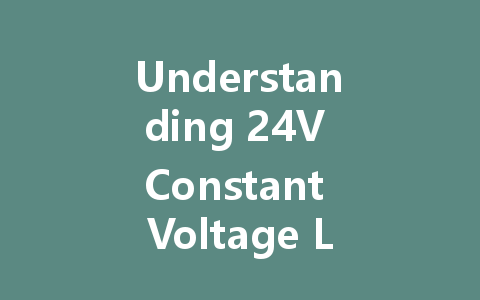In the ever-evolving world of LED technology, constant voltage drivers play a crucial role in ensuring that LEDs operate efficiently and safely. This article delves into the essential aspects of 24V constant voltage LED drivers, including their principles, selection criteria, and how they compare to constant current drivers.
Was ist ein LED-Treiber mit konstanter Spannung?
A constant voltage LED driver is a power supply designed to provide a fixed output voltage, maintaining a stable performance in LED lighting systems. Unlike constant current drivers, which adjust the output based on the load, constant voltage drivers deliver a consistent voltage to the connected LED lights, making them ideal for applications such as LED strips and fixtures.
Das Prinzip des Konstantspannungsantriebs
The principle behind constant voltage LED drivers is relatively straightforward. These drivers regulate the voltage output to ensure that it remains constant (in this case, 24V). This consistency is vital for maintaining the brightness and color quality of LED lights. When the driver senses a drop in voltage due to increased current draw (for example, when more LEDs are added), it compensates to ensure the output voltage remains steady.
Advantages of Using 24V Constant Voltage Drivers
How to Choose a Model for Constant Voltage LED Drivers
When selecting a 24V constant voltage LED driver, several factors should be considered to ensure optimal performance:
Always check the total wattage of your LED fixtures. Choose a driver that can handle a wattage rating higher than your total requirement to ensure reliability and prevent overheating.
Make sure the driver provides a stable 24V output, as using a driver with a different voltage could damage your LEDs.
Opt for drivers with higher efficiency ratings, typically above 80%. Efficient drivers minimize energy loss and heat generation, which is crucial for maintaining a cooler operating environment.
Select drivers with built-in protections against over-voltage, over-current, and short-circuit conditions. These features will prolong the life of your LED lights and ensure safe operation.
Comparing Constant Current and Constant Voltage Drivers
While constant voltage drivers are perfect for certain applications, it’s essential to understand how they compare with constant current drivers.
Konstantstrom-Treiber
Constant current drivers are designed to provide a steady current output to LEDs, making them suitable for applications such as spotlighting, where brightness consistency is critical. However, these drivers are not as versatile as constant voltage drivers when it comes to powering multiple LED fixtures.
Choosing Between the Two
In general, if you’re working with LED strips or fixtures that require uniform voltage, a constant voltage driver is the better choice. On the other hand, constant current drivers might be preferable for specific high-precision lighting applications, like architectural lighting.
Circuit Diagram of a 24V Constant Voltage Driver
A basic circuit diagram of a 24V constant voltage LED driver typically includes a transformer, rectifier, and regulator. The power supply converts the alternating current (AC) from the mains to direct current (DC), and the regulator maintains the output at a steady voltage, ensuring compatibility with the connected LEDs.
Common Applications of 24V Constant Voltage LED Drivers
These drivers are widely used across various applications, including:
Fazit
Understanding 24V constant voltage LED drivers is essential for anyone involved in lighting installations or design. Their simplicity, efficiency, and versatility make them a popular choice in the industry. By considering wattage requirements, output voltage, efficiency ratings, and protection features, you can ensure that your LED lighting system operates flawlessly and efficiently. Whether you opt for constant voltage or constant current drivers ultimately depends on the specific needs of your project, but a solid grasp of each type’s principles will help you make the best choice for your lighting solutions.
